You’ve probably been there: you spend hours creating the perfect blog post…with one final review, you cautiously click publish. Now you wait. You obsessively refresh the analytics page. Two or three days have passed…where are the visitors? You quickly realize that your content won’t spontaneously go viral and magically find an audience.

Lesson learned: Audiences have to be earned.
As indicated in the recent NY Times Innovation report, you don’t automatically get an audience by publishing self-proclaimed “viral” content. At the end of the day, you have to start hustling for links and stop believing in the “field of dreams” content strategy.
Why Is It So Difficult to Reach Audiences Today? Creation, Consumption, and Competition
I see two forces that are contributing to this reality.
Explosive Increase in Content Volume
Just today, there will be over 3 million blog posts published—up from 1.6 million in 2012. With Facebook and Twitter approaching 2 billion users combined, the flood of tweets and updates are also surging. According to Facebook, a user has the potential to be served 1,500 stories in their newsfeed each time. Visit Facebook 10 times per day? That’s 15,000 stories in a day.
“The sheer amount of stuff out there competing for your audience’s attention is staggering and if you’re not satisfying the consumer every time you’re at risk of losing them.” – Matt Creamer, KBS+ Executive Editor.
Diminishing Attention and Fragmentation
A staggering 55% of internet users spend less than 15 seconds on a page. While attention per/page is declining, the rapid growth of content is creating a massive content menu from which we can infinitely snack to our heart’s content. This shift is validated by eMarketer, where they found consumers are spending more cumulative time online with more sites.
“Today’s consumer spends an astonishing amount of time scrolling through feeds- news feeds, social feeds and messaging feeds. No longer unique to mobile, feed-based consumption is ubiquitous.” – Dan Greenberg, CEO and Founder of ShareThrough

In our current content economy, supply has outpaced demand creating this noisy place that we call the Internet. As a brand this reality paves way to an exceedingly competitive market to influence a finite audience and gain their attention.
3 Steps to Take Your Paid Distribution from Good to Great by @lukekintigh
In this current environment, an intelligent paid media strategy is more imperative than ever to the resonance of your content. As BMW’s Kate Alini simply put it in a recent Fast Company article, “If we’re going to spend money in production and content creation, we need to put media spend behind it.” Paid media is also getting smarter with the abundance of personalized data. “Targeted paid media addresses a new need created by the massive amount of content and the ever-shrinking attention spans,” said Adam Singolda, CEO of Taboola. “It helps us find content we may like but never knew existed.”
Here are three strategic best practices I’ve learned about optimizing paid media to create a winning distribution strategy for long-term success.
1. Build Equity in Your Paid Media Investment: Why Rent When You Can Own?
As John Battelle wrote earlier this year, there’s danger in brands investing for the long-term in social platforms that they ultimately don’t own. By building their house on rented land a brand has little to no control over the access and ownership of their audiences. Where’s the proof? Look no further than Facebook’s algorithm that has pushed organic reach lower than the interest of a modern-day saving account—down to 1% from 16% in 2012. Make no mistake, your Facebook audience belongs to Facebook. Your brand is merely using the platform to lease its users.
So what’s a brand to do given the perils of renting audiences? Is there lasting pay off to spending thousands, often times millions, on paid media? Yes, and here’s why—queue the rent to own mantra. You see, renting is only a temporary means to owning. With the right strategy, a brand can progressively move from purely renting its audiences to owning them.

This strategy comes down to your true objective of paid media—it must be, first and foremost, about converting the audience you’re renting into “owned” subscribers. Whether you’re promoting content on Facebook or on a native advertiser, the top goal should be moving an engaged user from a rented “like” or page view to a bonafide brand subscriber. Once subscribed, you no longer have to “rent” this user from the media—you effectively control your communications with them through owned channels.
Although driving subscriptions is the first step to rent-to-own, it doesn’t end there—from there the audience must be cultivated. “It’s not cheap or easy to deliver quality content each and every visit, but to build long-lasting loyalty you have to,” said Matt Creamer, KBS+ Executive Editor. “The lesson of disruptors like BuzzFeed, Vice, Gawker Media and Business Insider is that publishing success begins with identifying your audience, figuring out their wants and needs, and then repeatedly fulfilling them.”
Battelle concludes his post with a message to marketers: “If I were you, I’d get back to your own domain. Spend your money building something worthy, then spend to drive people there.” Brands such as Kraft, John Deere, and Red Bull have done just that. They’ve created world-class media properties where they’ve aggregated millions of subscribers. In fact, their publications rival and often times surpass genuine publishers in their respective verticals in audience size. They essentially don’t need the media anymore to amplify their content—they have become the media.
Buckle up! This approach will take time. It’s not a campaign. It’s a long-term strategy. It will take years, not months, to reap the fruits of your labor. Just ask John Deere—their 1.6 million Furrow subscribers is a product of a 119-year effort.
The Furrow by John Deere: Breaking Ground in Content Marketing Since 1895

- Circulation: 1.6 million subscribers in over 40 countries
- Created: 1895
- Industry Strength & Competition: Largest global agriculture publication
The Red Bulletin by Red Bull: Going EXTREME with Brand Publishing!
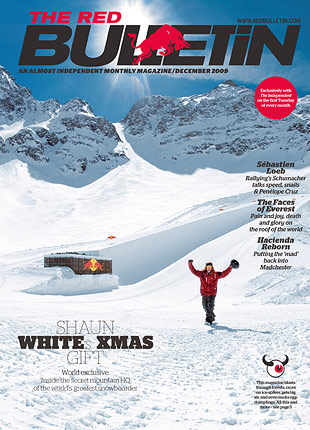
- Circulation: Over 5 million subscribers in 12 countries
- Created: 2007
- Industry Strength & Competition: Largest extreme global sports publication
Food & Family by Kraft: Dishing Out Premium Recipe Tips to the American Family

- Circulation: Over (paid) 1 million subscribers
- Created: 2002
- Industry Strength & Competition: Subscription rates are larger than Food & Wine and similar to the Food Network.
2. Socialize Your Content! Tapping the Power of Social to Drive Traffic Growth
Chances are you may be reading this because you discovered it via a social network. You’re not alone. According to SimpleReach, overall traffic driven by social will go from 25% in 2012 to a projected 53% by 2015.

Source: SimpleReach
Now, referral traffic sources will vary depending on the site and audience, but the future trend is—it’s social that publishers will have to master in order to sustain and grow their audiences. Traditional publishers such as the New York Times, have struggled to adopt this change with less than 10% of their traffic coming from social. Conversely, hyper-growth publishers like BuzzFeed, Upworthy, and Viral Nova are getting north of 70% of their traffic from social. Speaking for iQ, 61% of the site’s traffic comes from social in 2014, up from 45% in 2013.
So what have these viral publishers and the iQ team learned about leveraging social to accelerate traffic? Here are 5 key takeaways.
Finding the Channel/Device Sweet Spot
We all know the proliferation of mobile is accelerating consumption from desktop to mobile. However, the patterns and levels of mobile vs desktop vary by social channel. According to Nielsen, Twitter users only spend 36 minutes/month on desktop compared to over 6 hours on Facebook. Also, time of day influences mobile and desktop patterns. We see mobile consumption spike in the evenings and mornings for iQ.
Takeaway: Allocate your budget and targeting according to the patterns you’re seeing across time, channel and device.
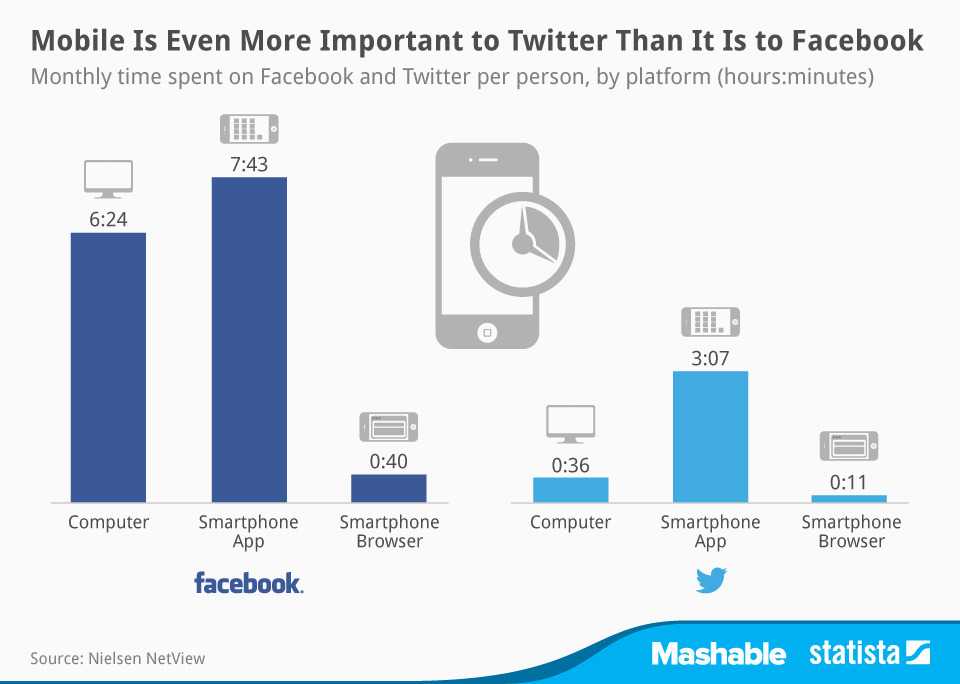
Source: Mashable via Nielsen
We all like to focus on cost per click and page views metrics, but don’t forget about post-click data. “The click is not as important as the share, and you can’t trick sharing.” said Ken Blom, Director of Social Discovery at BuzzFeed. These actions may not be a share. It will depend on your objectives, but it’s important to look end-to-end at how social channels drive both the initial traffic and desired action that you want the reader to take.
Takeaway: Analyze your desired post-click actions, such as subscriptions or bounce rate, against each social channel that drives it.
Facebook Is King!
When it comes to social, Facebook rules the traffic referral kingdom. According to Shareaholic, Facebook drove over 21% of the overall traffic sites received compared to only 7.1% for Pinterest and 1.1% for Twitter in March 2014. Viral Nova and Upworthy receive 58-65% of their traffic from Facebook alone. About 44% of iQ traffic comes from Facebook.
Takeaway: While Facebook’s limiting organic reach may cause pause, from a paid perspective the platform delivers like no other channel to refer traffic at scale and efficiency.
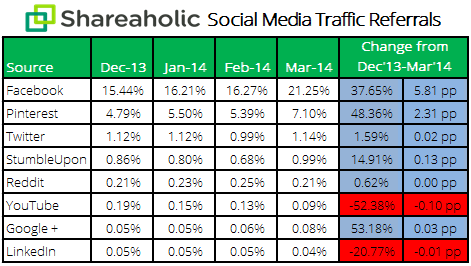
Source: Shareaholic
Calibrate Frequency and Shelf Life
How many times/day can you post to each social channel? Answer: it depends, but there are some core principles to follow. According to TrackSocial, the optimum frequency of tweets per/day is much greater than Facebook and LinkedIn, but the shelf life of a tweet is much shorter than other platforms. SimpleReach data indicates that trending posts on Facebook last nearly twice as long as Twitter.
Takeaway: Closely evaluate the length of performance and how frequency impacts engagement per network to fine-tune the levels of content production and promotion.
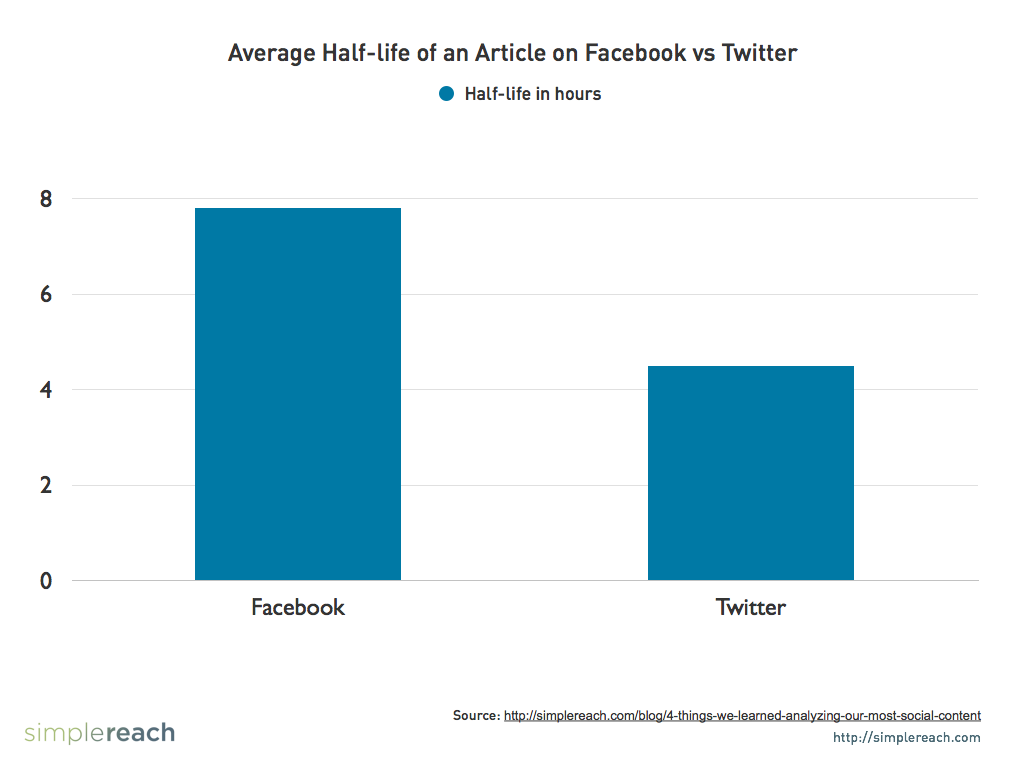
Delivering on the Promise and Expectation of the Platform
In a feed-based content economy, users are likely using social platforms to discover story-driven content that speaks to their interests, not an irruptive sales pitch. “Just because you’re advertising on social platform does not mean you’ve created a social ad,” said Ken Bloom, Director of Social Discovery at BuzzFeed. “Far too often we see brands taking their banner assets and framing them into a Facebook Sponsored Post.” Remember that native ad units require “native” content—it’s both a form and function.
Takeaway: Bare in mind the inherent behavior of social users as you may be tempted to use direct sales or bottom funnel content.
3. Optimize, Optimize, Optimize: Be a Day Trader, Not a Mutual Fund Manager
As I’ve alluded to in my previous posts distribution is extremely complex today. The platforms in which audiences are discovering content are growing by the day. This fact commands a paid distribution strategy that’s agile and diversified. Constant optimization is the lifeblood of successful paid distribution. It will be the difference between 100,000 and 10,000 page views. Between a $0.80 and $0.08 Cost Per Click (CPC). And most importantly, between winning and losing audiences.
Relying on a broadcast, publish and pray strategy will limit your effectiveness. “Producing a single piece of content is like playing the lottery in that there is no guarantee it will resonate with your audience,” said Eddie Kim, CEO of SimpleReach. “Therefore, one of the keys to an effective content strategy is producing enough volume combined with an intelligent distribution strategy that identifies and amplifies your top content.”
Here are 4 tactics that can turn you into a rock-star day trader from a buy and hold mutual fund manager.
10 > 90 Rule: Find the Winners and Double Down
When optimizing iQ content for traffic performance, we found that just 10% of content drives 90% of traffic. According to SimpleReach’s research from over 5,000 sites this trend holds true for all publishers that optimize for traffic.” The 90/10 rule holds true for pretty much all media, whether it’s publishing, music, television, or film,” said Eddie Kim, CEO of SimpleReach. “The nature of digital distribution is that the winners have become bigger than ever.” Knowing that only 1 out 10 posts will have legs, ensure you have the volume necessary to truly optimize.
Takeaway: Find the winners (the 10%) early and often—double down and accelerate their performance with further investment.
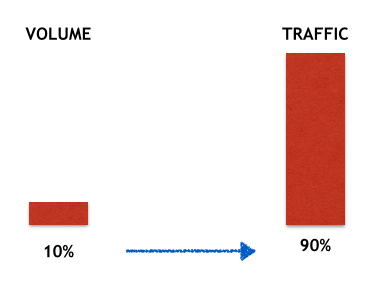
Time = Money: Taking Action Early Is Critical
Waiting even hours to take action on deploying trending content into the market can cost you. The sooner you take action, the greater velocity and efficiency you’ll see from your media. Weekly and even daily performance reports won’t enable this ability—you need real-time capabilities and reporting. Having the tools to know at a minute’s notice when recently published content is taking off is essential to taking action.
Takeaway: Set up a system and process to quickly get content into market across several platforms with variations of copy and creative.
Fixed vs. Flexible Spend: Say No to Buy and Hold
The speed and diversity of how content travels greatly varies. We may know key principles of paid distribution, but invariably you can’t predict virality. To find the winners you have to practice a flexible approach to initially identify where to focus and then make intelligent decisions against what content and channel is performing. “When you’re using a predetermined media mix you lose the ability to optimize toward critical times in a piece of content’s lifespan,” said Ken Blom, Director of Social Discovery at BuzzFeed.
Takeaway: Diversify and then refine against performance indicators.

Fully Utilize Every Attribute of Your Content
Don’t get in the pattern of simply promoting a single headline and image for each article you promote. Testing and changing headlines and visuals can breathe new life into the discovery of a post. Utilize different images and subheads in the article to promote every attribute of the content separately. List posts work very well for this where you can test every item in the list against interest targeting with multiple ad units to determine what’s working.
Takeaway: Test multiple elements of longer form content to identify what creative and copy is resonating.
While this post focused on post-publishing strategies, infusing distribution into the production of content is also crucial. Make sure to check out the first two sections in the series. In my next post, I’ll cover the final section in the series—shifting from paid media and post-publishing tactics to operation and process for distribution.
The Ultimate Content Distribution Guide:
- Section 1: Building and Leveraging a Network of Writers for Distribution
- Section 2: How to Bake Distribution into Your Production Recipe
- Section 3: The Role of Paid Media to Amplify and Optimize Content – current post
